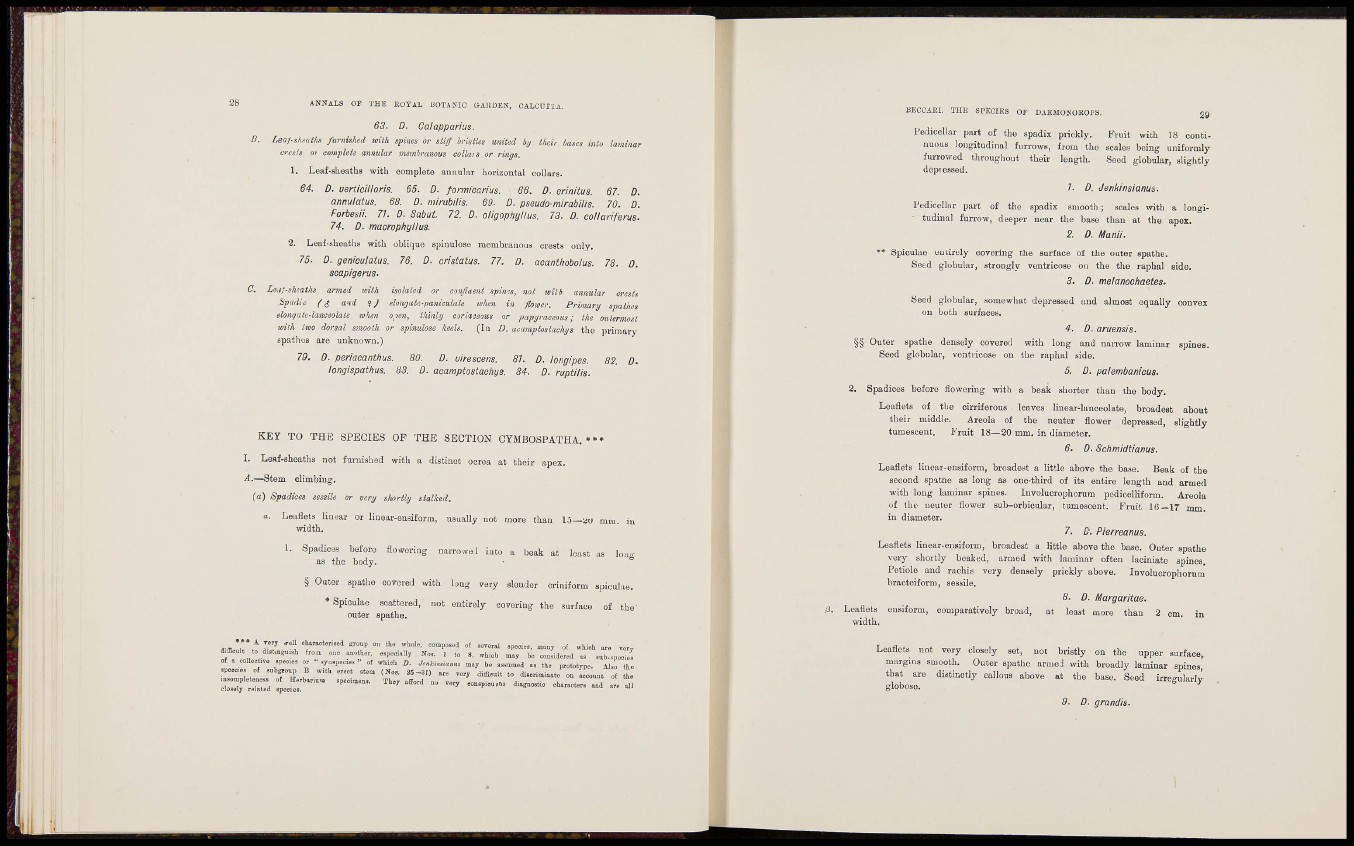
ANNALS OF THE EOYAL BOTAKIC GAitDKN. CALCUriA.
63. D. Galapparius.
B. Leai-sheaihs furnished with spines or stiff bristles united by their bases into laminar
crests or complete annular membranous collais or rings.
1. Leaf-sheaths with complete aiuiulav horizontal collars.
64. D. uertiGi'lfaris. 65. D. formfcarius. 66. D. crinitus. 67. D.
annulatus. 68. D. mimbiiis. 69. D. pseudo-mirabihs. 70. D.
Forbesii. 7h D. Sabut 72. D. oligophyllus. 78. D. collariferus.
74. D. macrophyllus.
2. Leaf-sheaths with oblique spinulose membraaoua crests only,
75. 0. geniculatus. 76. 0. crisfatus. 77. D. acanthobolus. 78. D.
scapigerus-
C. Z?Ki/-sh':at/is armed with isolated or aonjlueni spinis, not with annular crests
.^padic (• $ a'ld <i) elongate-paniculate token in flower. Primary spathes
elongate-lanceolate when ikinly ecriaceous or papyraoeous; the outermost
with two dorsal smooth or spinulose kech. (In D. acamptostachgs the primary
spathos are unknown.)
79. D. periaoarithus. 80. D. uirescens. 81. D. hngipes. 82. 0.
longispathus. 83. D. acamptostacfiys. 84. D. ruptiHs.
KEY TO T H E SPECIES OF THE SECTION CYMBOSPATHA.
I. Leaf-sheaths not furnished with a distinct ocrea at their apex.
A.—Stem climbing.
(a) Spadicea sessile or very shortly stalked.
a. Leaflets linear or linear-ensiforcn, usually not more than lo—ao mm
width.
1. Spadices before floweriag naiTowel into a
as the body.
at least as long
§ Outer covered with long very slender criiaiform spiculae.
• S p i c u l a e scattered, not entirely covering the surface of the'
outer spathe.
^ ^^^ charaoteriBod eroup on tha whole, composod of several speoiea, macT of ,
TSry
dLffloalt to fro3 o.e another, especially Nos. 1 to 8. which may be considered as sub-.p.cie,
of a collec ,ve .pec.es or " synspecies " of which i). Jenkin^ian.s may be assumed as the prototype. Also th^
speaces of sub^onp B w.tU erect atecn (Nos. 25-3,.) are very difflcalt to discrimiaate o. Lcount S L
all
BECCAEI. THE SPECIES OP DAEMONOROPS. gg
Pedicellar part of the spadix prickly. Fruit with 18 continuous
longitudinal furrows, from the scales being uniformly
furrowed throughout their length. Seed globular, slightly
depressed.
7. 0. Jenkinsianus.
Fedicelliir part of the spadix smooth ; scales with a longitudinal
furrow, deeper near the base than at the apex.
2. 0. Manii.
' Spiculae entii-ely covering the surface of the outer spathe.
Seed globular, strongly vontricose on the the raphal side.
3. D. melanochaeteS'
Seed globular, somewhat depressed and almost equally convex
on both
4. D. aruensis.
§§ Outer spathe densely covered with long and narrow laminar spines.
Seed globular, ventricose on the raphal side.
5. D. palembanious.
2. Spadices before flowering with a beak shorter than the body.
Leafl.et8 of tlie cirriferous leaves linear-lanceolate, broadest about
their middle. Areola of the neuter flower depressed, slightly
tumescent. Fmit IS—20 mm. in diameter.
6. D. Schmidtianus.
Leaflets linear-ensiform, broadest a little above the base. Beak of the
second spatUe as long as one-third of its entire length and armed
with long laminar spines. Involucrophorum pedicelKform. Areola
of Ihe ueuter flower sub-orbicular, tumescent. Fruit 16 — 17 mm
in diameter.
7. D. Pierreanus.
Leaflets linear-ensiform, broadest a little above the base. Outer spathe
very vshortly beaked, armed with laminar often laciniate spines.
Petiole and rachis very densely prickly above. Involucrophorum
bracteiform, sessile.
/3. Leaflets eosiform, comparatively broad,
width.
8. D. Margaritae.
least tQore than 2 cm.
Leaflets not very closely set, not bristly on the upper surface
margins smooth. Outer spatlie armej with broadly laDjinar spines,'
that are dietinotly callous above at the base. Seed irregularly
9. D. grandis.